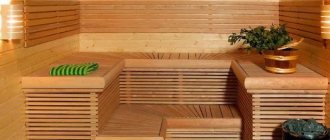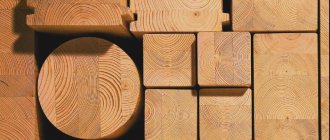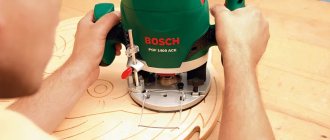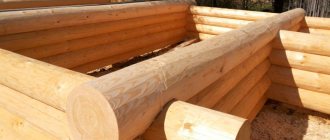After making the decision to build your own cottage, it’s time to think. The most important choice to be made almost always concerns the building material. Let's compare the two most popular options. So, which house is better: brick or wooden? Both materials have advantages and disadvantages, but they may have different meanings for the future owner of a country cottage.
Fig.1. Often there is a choice: to build a brick or wooden house?
Pros and cons of a brick house
The strengths of brick buildings are that they:
- Durable and resistant to climatic factors.
- Not susceptible to destruction by insects and harmful microorganisms.
- They can be used for decades without the need for façade repairs.
- Resistant to fire, can be restored after a minor fire.
The list of advantages is considerable. But brick houses have significant disadvantages that also have to be taken into account. This:
- The heaviness of the building material. For this reason, it is necessary to build a stronger, more expensive foundation.
- High construction costs. As a rule, brick is more expensive than wood materials. The labor costs for constructing such walls are also high.
- Unpresentable appearance without decorative finishing. Without finishing, a brick wall looks unattractive.
Based on the totality of the strengths and weaknesses of this building material, we conclude: it is better not to build seasonal cottages made of brick. Cottages for permanent residence can be built from this material. But before making such a decision, it is also worth considering another option - natural wood.
Fig.2. Building a high-quality and pleasant-looking brick house will bring more costs.
Time to build a house
The construction time for a wooden and brick house differs significantly. As you know, time is money, so if we are looking for savings, we will find it right here. The construction of wooden houses is much lighter than brick ones. This impacts foundations, which are required to be smaller in width and therefore cheaper to construct.
The only wet work is pouring the foundation, which makes construction possible at any time of the year. In addition, the technology is based on a lightweight design, which allows you to quickly and economically build a summer house in any season. The situation is different with log houses. Their walls are made of thick horizontal logs. Therefore, they are slightly heavier than their frame counterparts. However, their total weight is still less than that of stone buildings.
It is also worth noting that most of the frame of the house is made in production shops. Therefore, finished elements and semi-finished products are delivered to the construction site, which reduces construction time.
Frame house with an area of 150 sq.m. can be done turnkey in 3 months, because this is a dry technology that does not require curing the object, as in the case of stone. Unfortunately, brick and block construction cannot be accelerated. By not observing the necessary technological breaks, you can risk consequences such as plaster falling off, floors “raising” or the appearance of fungus. With good planning and favorable weather conditions, a small cottage can be built in less than a year, but it is better to immediately plan for a longer period.
Pros and cons of a wooden house
Advantages of wood building materials:
- Relatively light weight. Wooden buildings can be erected on inexpensive columnar or pile foundations.
- High speed of wall construction. It takes only 2 months to implement finished projects made from laminated veneer lumber.
- Less high construction cost. In most cases, wood is cheaper than brick.
- Environmental friendliness. From a health safety point of view, there is no cleaner building material than wood on the modern market.
- Creating a comfortable microclimate. A well-heated wooden house retains heat longer in winter. In hot summers, on the contrary, it is cooler.
There are also disadvantages to buildings made of logs and timber. The main disadvantages of such materials include:
- Instability to destructive factors. Wood can rot and be damaged by insects and molds.
- Low fire resistance. The fire quickly spreads along the wooden walls, often completely destroying the house.
- Shrinkability. Solid materials with natural moisture dry out over time. Therefore, finishing and some arrangement work sometimes have to be carried out only a year and a half after construction.
Let us compare these two types of buildings according to two more important indicators.
Which home is better for living?
Wood is a living material with a number of advantages over brick. Nothing compares to a real wooden home. It is environmentally friendly, comfortable, cozy, has the ability to regulate humidity, and creates its own microclimate. It is cool in summer and warm in winter. Apartments made of wood have fresh, clean air, living there is good for your health.
But when deciding to build a wooden house, it is important to remember that you will have to take care of it often. Its appearance deteriorates and deformation occurs. It needs to be properly treated every few years. Brick does not require any maintenance.
Although if you use laminated veneer lumber, which is free from the disadvantages of wood, you can avoid many problems. This modern material is resistant to climatic and biological damage, fire, and has a low shrinkage percentage.
Structures made of timber are very popular in Canada, the USA, and Scandinavian countries. In the last few years, residents of Europe and the CIS countries began to often install them.
Combined buildings are also in demand. The bottom of such a dwelling is made of brick, and the top is made of wood. Its interior decoration involves placing highly flammable rooms on the ground floor: dining room, fireplace, kitchen, bathhouse. In the second, ecological one, bedrooms and children's bedrooms are usually set up.
Which home has a healthier microclimate?
Wooden walls are able to absorb excess moisture in damp weather and release it into the room when the air is extremely dry. This does not happen in a brick building. In rainy weather and poor ventilation, condensation accumulates in it, which is especially noticeable on windows or plumbing pipes. This is due to the low vapor permeability of brick. All types of this material are significantly inferior to wood in this indicator. Its structure has a large number of microholes through which not only steam but also air passes well. This is why they say that wood breathes. In a house made of logs or timber, the air is fresher, cleaner, and a comfortable microclimate is always maintained. For this property, no building can compare with a wooden dwelling.
Fig.3. A wooden house warms up faster and regulates the microclimate better.
Main Differences
Discussions about which house is considered the best have been going on for thousands of years. Both materials deserve the right to be leaders, although they are very different from each other.
There are generally three differences between log and brick buildings.
- Price. The cost of natural raw materials and the payment for its installation is lower compared to brickwork. The large thickness of the walls of a brick building and the complex base for it also significantly increases the final price.
- Reliability. Brick cottages are leaders in terms of durability. But with the use of modern processing methods, structures made of profiled timber can also last quite a long time.
- Thermal insulation. To build a family nest made of brick, additional insulation is required, and wood itself has excellent thermal insulation properties.
You may be interested in: Projects of houses with an attic and a garage
Which house is warmer: wood or brick?
Heat conservation is one of the most important criteria for choosing a home. The thermal conductivity coefficient of a brick wall is 4 times higher than that of a wooden one. Therefore, a cottage made of logs or timber:
- Heats up quickly. Once cooled, a brick structure is much more difficult to heat.
- Gives off heat more slowly. This makes it possible to spend less money on heating.
- Does not require additional insulation. Brick freezes much faster.
At the same outside temperature, a wooden house will be warmer. Thermal energy losses through its 23 cm thick walls will be lower than through 50 cm brickwork. Therefore, houses made of this material have to be regularly heated in cold rainy weather. If you don’t do this, the inside of such a home will be chilly, damp, and uncomfortable.
Which is more profitable in terms of finances?
If we take into account that the wood will have to be additionally processed, we can conclude that the costs of brick and wood are almost the same. But don’t forget about the costs that lie ahead. So, when choosing a brick, you will need a complex, reliable foundation. This is a significant investment compared to wood. In addition, insulation and increased wall thickness will be required. Therefore, it will take more money to build a brick house.
You should not discount the time costs either. It takes a long time to lay a brick. After laying it, insulation and finishing are required. Time is allowed between each layer. Even though wood shrinks and you have to wait time, the construction will still be completed faster than with brick. It is, of course, worth taking into account the availability of materials, the remoteness of the forest zone, the climate and the complexity of the project.
Thus, it is impossible to say categorically which is better, brick and wood. Each option has its advantages. Therefore, you first need to evaluate desires, possibilities, financial and time costs, as well as wishes for the house project. Only after this will it be possible to make a choice.
Detailed comparison of the main characteristics
For a deeper understanding of the difference between the two popular materials, let's consider their numerical characteristics.
Distinctive properties of wood and brick:
| Characteristics | Brick | Tree | ||
| Silicate | Clay | Log | Glued laminated timber | |
| Density, kg/m3 | 1780 | 1630 | 540 | 450 |
| Thermal conductivity, W/m°С | 0,81 | 0,64 | 0,16 | 0,14 |
| Weight of 1 m2 of wall, kg | 1200 | 1150 | 225 | 100-150 |
| Eco-Friendly Factor | 5-6 | 1 | ||
| Sound insulation, dB | 42-60 | 41-50 | ||
| Labor intensity of construction work, person*h/m3 | 2 | 1 | ||
conclusions
An analysis of all the pros and cons shows that wood has many advantages over brick. This will become even more obvious if you look at the most modern type of wooden building materials - laminated veneer lumber. It does not have many of the disadvantages of solid wood: it is subject to minimal shrinkage, and is more resistant to fire, biological and climatic damage. Glued laminated timber also has lower thermal conductivity. And its strength is 2.5 times higher than that of solid wood with natural moisture.
The difference in cost between brick and laminated veneer lumber is small. But when choosing the first material to build a cottage, you will also have to incur additional costs. Thus, more funds will be required for the construction of the foundation, construction of walls, insulation and interior decoration. Thus, laminated veneer lumber is superior to brick in almost all respects.
Features of using wood in construction
Wood is a traditional material in domestic construction. Today, the most popular structures are made from profiled, laminated timber and rounded logs. Each option has a number of advantages that are worth exploring separately.
A rounded log will allow you to build a log house in a classic style Source srubmoscow.ru
Additional thermal insulation of buildings
Additionally, you can ensure maximum heat retention in the house by using external insulation by building a ventilated façade. The essence of this is to place profiles on the walls on which the finishing material will be fixed, depending on the tastes of the owner.
Various insulation is placed in the resulting space. Most often used:
- Styrofoam;
- Mineral wool;
- Expanded polystyrene;
- Ecowool, glass wool.
The list is not complete; the variety of products for insulating buildings on the market is very wide. First of all, they are subject to requirements for non-flammability, durability and environmental friendliness for residents.
When building such external insulated facades, you need to carefully consider the ventilation system. If this requirement is not met or not fulfilled fully enough, then fungus and mold may appear on the walls, which will ultimately lead to the process of rotting and loss of properties of any insulating material.
What materials are walls made of best to retain heat in winter?
Tree
Not so long ago, the most common material in construction was natural wood. All the village houses, even in harsh winter conditions, made it possible to live in them quite comfortably and not freeze.
In addition, a big advantage of building buildings from solid wood is that there is no need to carry out finishing work on the outside, and even on the inside it is minimal.
At the moment, the construction of houses from logs has faded into the background; frame and timber houses have become more common.
For our climate zone, it is recommended to insulate them with at least a small layer of insulation, especially for cottages made of timber. The thermal conductivity of wood is quite low - 0.10-0.15 W/(M*k).
The advantages of such buildings are the following qualities:
- The total weight of the house is relatively small; you can get by with a simple foundation;
- They say about wooden cottages that they “breathe” and this is true. The well-being of people living in them is much better;
- A wooden structure with a wall thickness of 20 cm can retain more heat than a brick wall with a thickness of 50 cm;
- It is possible to dismantle and move the building to a new location (which, however, is very labor-intensive);
- The facility can be built by a team of 3-4 people in a couple of months.
The disadvantages of wooden buildings are also significant:
- The house continues to shrink for up to three years, but you can live 5-6 months after construction;
- The most significant disadvantage is that wooden buildings are very flammable. When staying, it is imperative to observe fire safety measures and treat the walls with special compounds;
- Insects are also enemies of such buildings, especially bark beetles. Modern industry produces various mixtures for wall treatment. This is a fairly important condition for maintaining the integrity of the building for a long period of time;
- It is necessary to ensure sufficient ventilation of the walls, otherwise the process of rotting and mold formation may begin.
Brick
Probably, we can safely put it in second place among building materials; literally 20-25 years ago there was no worthy alternative to it at all.
Brick houses themselves are very warm, since brick has a thermal conductivity coefficient of 0.47-0.70 W/(M*k). For the European winter, this is an ideal option, but this coefficient is not enough to maintain a comfortable temperature in the northern regions, and heat loss through the cement mortar is twice as large.
For greater heat retention in brick houses, an insulating layer of foam boards or other similar materials is installed on the outside and finished with siding. Although, with sufficiently thick external walls and a properly selected heating system, you can do without this.
Advantages of using bricks in construction:
- Houses built in compliance with all standards are very strong and durable. The service life can reach several hundred years;
- They tolerate any aggressive environment well - snow, wind, temperature changes. Major repairs are not required for up to 150 years;
- Environmentally friendly building material. All components do not contain chemicals harmful to human health;
- Fire resistant, brick is not flammable, on the contrary, it even acquires additional strength during the firing process;
- Good sound insulation. Thick walls reliably protect against noise from the street, and household inhabitants do not interfere with each other listening to music or watching TV.
Like all other materials, brick has its disadvantages:
- High cost of construction work. You need a large amount of additional materials for masonry - mortar, mesh, lintels, etc.;
- The construction period of a house is much longer than, for example, from wood or aerated blocks, since the overall dimensions of the brick are much smaller;
- A team of 8-10 people is required to build a medium-sized cottage, which means additional wage costs;
- Due to the considerable weight, you need to take care of a reliable foundation in advance.
Foam block
Foam blocks (or gas blocks) have recently become widespread in Russia. They have the correct geometry, are light weight, and are manufactured with a hook, which makes installation easier.
In addition, foam blocks are inexpensive, and due to their large dimensions they allow construction to be carried out at a rapid pace. Due to the content of a large number of air bubbles in their structure, their thermal conductivity is in the range of 0.08-0.0 W/(M*k).
The downside of the material is its ability to absorb water, which negatively affects operation. Therefore, it is recommended to cover the outside of such houses, albeit not immediately, but within several years, with insulation and cover them with siding. Otherwise, loss of heat-retaining properties will occur within 5-7 years from the date of construction.
Let's summarize a little, so, the advantages of building from foam blocks:
- A team of 2-3 people will build a box house in a short time;
- Exterior finishing can be done in various ways, including inexpensive ones;
- Lightweight blocks, no expensive lifting equipment required;
- The blocks are assembled using an adhesive mixture, which is much more reliable than cement;
- Inexpensive and practical material, available even in the suburbs, delivery costs will not be expensive.
The disadvantages of this material are the following:
- The heat resistance of the material is even lower than that of wood and brick. Therefore, for buildings made of foam and gas blocks, it is important to have constant heating, otherwise the cottage will freeze quickly enough;
- After the house has cooled down, it will warm up for at least 8-10 hours, depending on the area of the building;
- Blocks, without good insulation from the external environment, constantly absorb water, and at subzero temperatures this water freezes, turns into ice and expands. This affects the safety of the material;
- During operation of 25-30 years, major repairs are most often required.
Frame and panel structures
They also became widespread in our country relatively recently. The advantage of frame cottages and dachas is the low cost of construction and fast construction time.
The essence of the technology is that to build a frame house, a wooden frame is built according to a specific design, then it is sheathed with panels, and several layers of insulation are laid between them.
As a rule, it is enough to retain heat until it loses its beneficial properties, this happens after 9-10 years of operation. To restore the thermal conductivity of the walls, they can be insulated from the outside and finished with siding.
According to the legislation in our country, heat loss at home must be within 0.02 W/(M*k). In “frameworks” this is achieved in the vast majority of cases by external insulation of the walls. This type of insulation allows you to save the internal space of the building, as well as achieve a more aesthetic and individual appearance.
Let's consider the positive aspects of frame structures:
- Low cost of building a cottage, a minimum of expensive materials are required;
- A team of 5 people is able to build a turnkey cottage in 1-3 months, depending on the complexity of the project;
- Construction work can be carried out at any time of the year;
- Possibility of installing communications inside the walls, which is much more aesthetically pleasing and makes their repair easier;
- Does not require a strong and powerful foundation;
- There is no shrinkage process, the house will remain as it was at the time of construction;
- The walls are perfectly smooth, which significantly saves finishing materials.
The disadvantages of these designs are as follows:
- Poor sound insulation, as the walls are not particularly thick;
- There is no possibility of redevelopment of the interior premises, since the project was created as a single whole;
- The need to replace the insulation, which, depending on the brand, needs to be changed after 10-30 years of operation. An alternative to this could be external wall insulation and covering with additional siding;
- The load-bearing capacity of the walls is limited. If you plan to hang something massive and heavy, you need to consider strengthening the required area in advance.
Calculate the value of your home:
In addition, a wooden house requires periodic maintenance, in particular, treatment with antiseptics, which prevent wood from rotting and protect it from the effects of rodents and microorganisms, while a brick house does not require such work. In general, a brick house will cost more during construction , but will not require further costs to maintain the walls in good condition, while a more economical wooden house will require further maintenance and expenses and this must also be taken into account when estimating construction costs.











